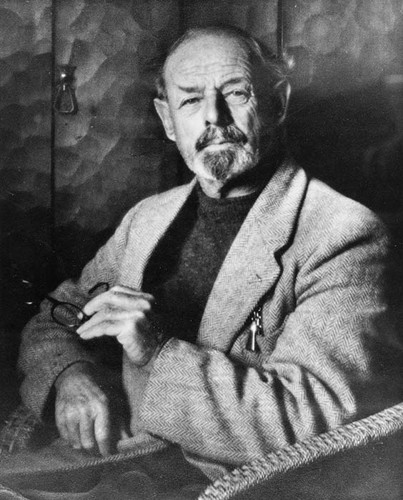
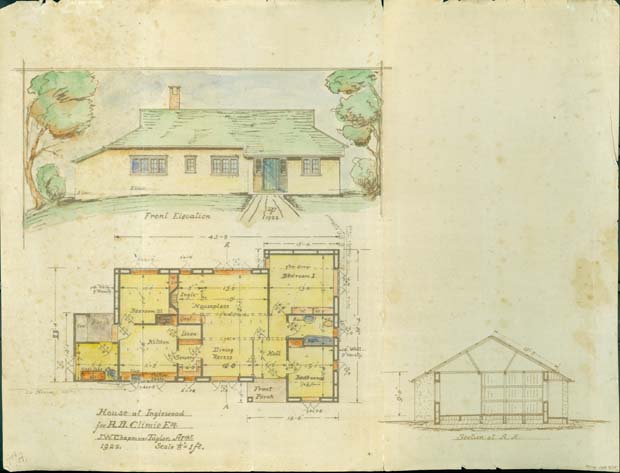
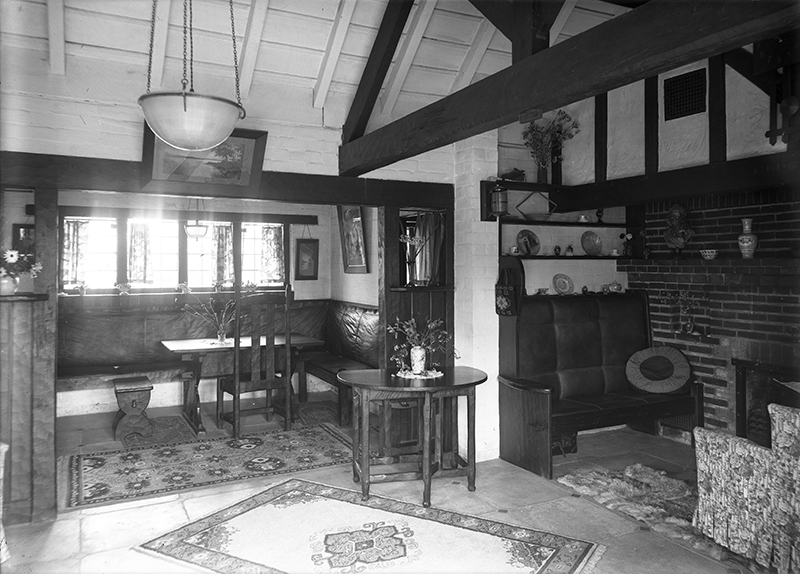
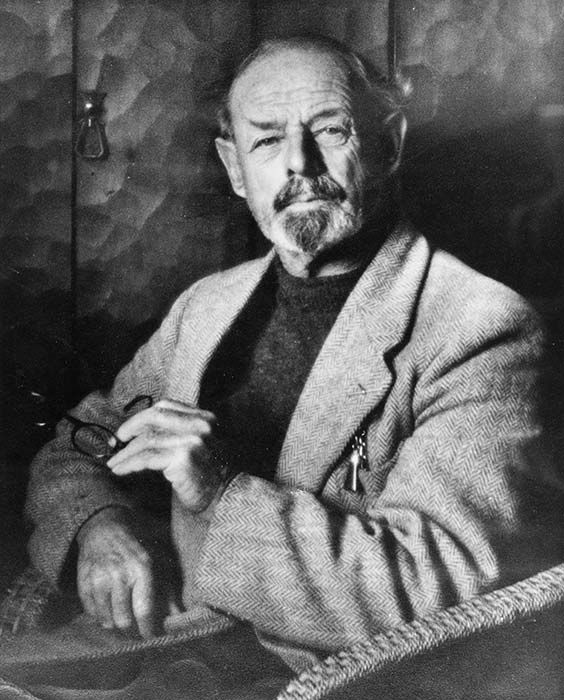
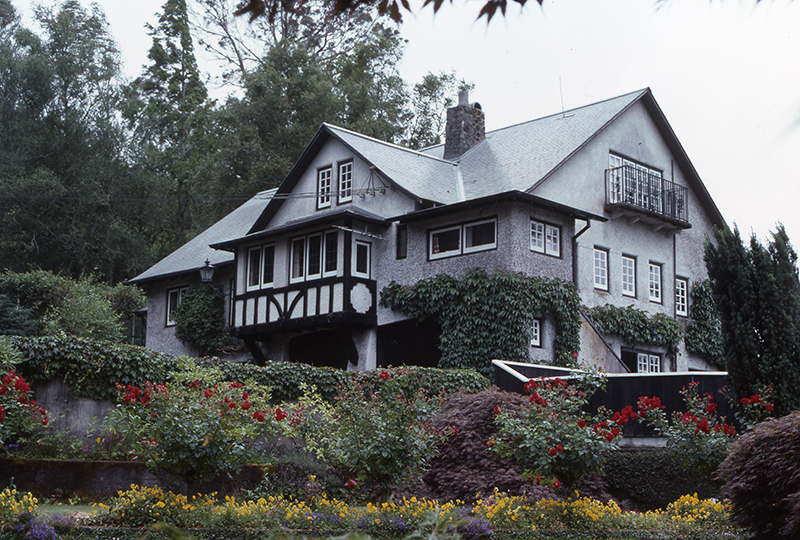
Permanency, honesty, simplicity, beauty and fitness were the guidelines followed by Taranaki architect James Chapman-Taylor throughout his 60-year career. James was dedicated to the New Zealand Arts and Crafts movement of the early 20th Century, earning the title of its most devoted disciple.
James Walter Chapman-Taylor was born in London on 24 June 1878. He was the first child of Ada and Theodore, a quantity surveyor. It was a time of economic depression in England and emigration was a popular option for those struggling to make ends meet. The family made the decision to move south to New Zealand and seek a new life in the little colony.
Theo travelled ahead and in late 1879 bought a 24 hectare block of land at Ngaere, a little settlement sandwiched between Stratford and Eltham. He named the property Rosanagh. Ada, two-year old James and baby Harold sailed to join him in 1880. Theo had cleared a small block of bush and built a little single-room cottage ready for his family's coming.
Their arrival was dramatic. "They were carried ashore from a lifeboat - by a husky sailor, and completed the journey by train… is it possible to imagine Ada's feelings as she viewed the unpainted shack, ten by twenty feet, just one bare room with a clay lined fireplace, chains suspended above on which to hang the pots… set in a small clearing overshadowed by forest giants…" wrote Judy Siers in her biography on Chapman-Taylor.
"...the fireplace of the shack had wire hooks dangling from a bar, a black kettle and a camp oven to bake bread in. I remember that chimney: it had several holes burnt in it where it had caught fire... Imagine a lady coming from a wealthy London home to that primitive state!"
James was initially taught at home by his mother, a former governess, linguist and accomplished pianist and writer. He didn't attend Ngaere School until he was eight years old. He wasn't interested in taking over the family farm when he left school. His brother Harold stayed on at Rosanagh and James became an apprentice to local Stratford builders Boon Brothers.
On 12 April 1900 he married Mary Gibson in Stratford. The couple's first child, Mary, was born a year later. After completing his apprenticeship James constructed his first building, a single storey timber house at Rosanagh for his parents. But he was searching for something more, he aspired to more than building houses for the people of Stratford. James enrolled in an architecture and design course with the International Correspondence School of the United States.
In 1905 the family moved to Island Bay, Wellington, where James set up a workshop in the city under the Chapman-Taylor name. He advertised himself as a 'maker of houses, gardens and furniture'. The Chapman-Taylor home was a talking point in the sleepy seaside suburb of Island Bay, dotted with baches and Edwardian villas. James had designed and built the house with an extended gable in the roof. This earned it the title of ‘church house’ from the locals.
It was the first of many houses which James designed and built for his family. Over the years the Chapman-Taylor's moved often, living in at least 11 houses that James designed and built. This gave him first-hand knowledge of what worked and what didn't in terms of a ‘liveable’ home.
While James became successful in his career he didn't appear to have the same fortune in his family life. Mary died in October 1916, a year later he married Clara Walton.
The family shifted to Havelock North, then on to Auckland before shifting back to the Wellington area in the 1930s. Clara and James divorced in 1937, that same year he married Dorothy Pocock. She died in 1938 and James married Marion Gottwaltz two months later.
A trip to England in 1909 to see the Arts and Crafts style first hand had a profound effect on James' future work. There he met architects C.F.A Voysey and Ernest Gimson. Voysey advised the young colonial to involve himself in the whole process of design and building if he wanted to achieve the greatest satisfaction. Gimson had helped establish an Arts and Crafts commune, providing a focus for craftspeople interested in reviving traditional skills from hand-adzing through to metal work and furniture making.
The Arts and Craft movement promoted a return to simple, traditional English cottage style, with interior features in adzed timber, whitewashed plaster walls, large beams, small framed windows and hand-crafted fittings – a lot like the ‘chocolate box pictures’ of pretty cottages in quaint villages amongst rolling hills.
Impressed with what he had seen, and the architect's advice ringing in his ears, James returned to New Zealand with a steadfast belief in the Arts and Craft principles.
The family moved to the Hawke's Bay, drawn there after James joined the circle of Dr Felkin, the founder of a hermetic order known as the Temple of the Golden Dawn. The group was as dedicated to healthy, rational living as it was to more mystical pursuits. The houses James built for its members became the prototypes for those he would build throughout his career.
His first concrete building for the order, Whare-Ra, included a temple, and signalled a more mature style - his designs became more cohesive. He experimented with honeycomb concrete wall construction, concrete blocks, and a variety of design features, but the Arts and Crafts cottage style still echoed throughout his work.
James' total commitment took him further than fellow Arts and Crafts architects – who were basically just designers. He believed everything should be built by hand, and preferably on site by skilled craftsmen. Materials available on hand - stone, shingle, trees - were used in construction to help blend the house into its surroundings. Of one of his houses he said: "It looks as if it has always been there, had grown quite naturally out of the ground so to speak, and would always be there. This I believe is a supreme test of its architecture."
Each material was coaxed to bring out its inherent qualities. Timbers - jarrah, kauri, macrocarpa - were hand adzed to “give them a woody character, and the forest origin of the timber is not lost”. Wrought iron latches, locks and handles made by a craftsman had hammer marks “showing how the glowing metal was beaten out by human hands”. Simple handmade wooden door handles and latches were used. Hardwearing tiles placed on floors, kitchen benches, and built-in baths.
The architect also made furniture, designing and constructing a variety of built-in or free standing, robust, hand adzed wardrobes, bureaus, cupboards and tables. A garden lover, James enjoyed helping landscape the grounds around the house, encouraging creepers to grow over the buildings to help it blend in and become one with its surroundings.
James was convinced that the house - the environment in which people lived and in which children grew up in - was a primary factor in shaping the moral conduct of society. Basically, a home helped shape the character and attitudes of the people within. He was a firm believer that a house had a soul as well as a body.
As Douglas Lloyd Jenkins writes in his book At Home, while his contemporaries were principled and essentially moral in their instruction "in any of Chapman-Taylor's interiors, every time a hand reached out to touch, at every tread on the stairs, every time you sat down and looked around, you were delivered a hand-wrought sermon in contemporary morality. You were going to be improved by the experience of living in one of these houses."
They were designed to make you think, to contemplate the effort gone into making the house, the beauty of the materials and design. And if you still hadn't got the message - the new home owners were gifted a book compiled of the house plans, photographs and the architects thoughts - a guide on how to live within the home.
On a slightly lower level James believed a house should express the genius of both man and woman - big and bold in conception and rugged in handling… masculine in frame and feminine in finish. "In it, as in the craftsman himself, there must be the marriage of two worlds, the practical and the aesthetic, the world of necessity and the world of romance…for man does not live by bread alone."
Going one step further - James would also recommend colour schemes to the future inhabitants. He believed colour had a psychological effect as well as an aesthetic one. "Yellow stimulates the mind, red the emotions, green soothes the nerves… a colour scheme that has to be lived with should be restrained and should contain some of all the colours of the spectrum."
While James' style was popular with the New Zealand public - he designed and built 84 homes in his 60-year career - he was criticised by some for what was seen as a derivative rustic style and pretentious building methods. James was equally scornful of modern architecture, writing: "Today we have the architect with iron bound specification, the builder with his 'lowest cut price' and the inevitable result - the worst architecture in history - machine made art."
The average modern-day New Zealand house was a “wooden shack, covered with a flimsy half-brick skin” according to James. He felt industrial production had robbed architecture and objects of any personality or character. He loathed the idea of mechanically produced objects, with their smooth, lifeless surfaces. To his eyes they had been robbed of all interest and had no story to tell.
Because he had a hands on approach to his work, James moved often, spending time in Wellington, Hawkes Bay, Auckland and Taranaki. He became widely known - more so than other architects of the day. According to author Douglas Lloyd Jenkins this, along with his distinctive style, resulted in him becoming the first New Zealand architect to create a personal mythology around his work. "This enabled him to transcend contemporary fashion in a significant way."
Long after New Zealand had moved away from the Arts and Crafts movement there were still a queue of people wanting Chapman-Taylor cottage-style homes.
Whilst excelling in architecture James also channelled his creativity into writing and photography. He wrote newspaper articles and took photographs to illustrate his work. As he experimented with special lenses and different exposures and paper, his photography became increasingly art-inspired.
James installed a darkroom in his Silverstream home and took up professional photography as a side-line to his architecture. His style, advertised as ‘Portraits in your home’, became popular as an alternative to the stiff and formal portraits provided by contemporary studios of the time.
The relationship between the spiritual and material concerned James throughout his life. He attempted to live for honesty of purpose, beauty in truth, and the greater reason for life, which were guidelines of the Arts and Crafts philosophy. He felt strongly about what he called “adulterated food” and synthetic clothing, and exhorted people to sweep such “deceptions” away. He dabbled in religion, at various times joining the Hermetic Order of the Golden Dawn, the Anglican Church, The Theosophical Society and the Liberal Catholic Church. Astrology also played a part in his life. He became an adept reader and interpreter of horoscopes and this too became a profession in his later life.
James Walter Chapman-Taylor died on 28 October 1958 at Lower Hutt. He was survived by his fourth wife and six children. At the time of his death there was still a queue of would-be clients for his unique styled houses. Above an inglenook in one of his houses is carved the legend “not all of me shall die”. The spirit of the architect lives on in his homes.
Jenkens, D.L. (2004). At home: a century of New Zealand design. Auckland: Godwit.
Siers, J. (2007). The life and times of James Walter Chapman-Taylor. Napier: Millwod Heritage Productions.
Puke Ariki Heritage Collection: James Chapman-Taylor
LinkPlease do not reproduce these images without permission from Puke Ariki.
Contact us for more information or you can order images online here.